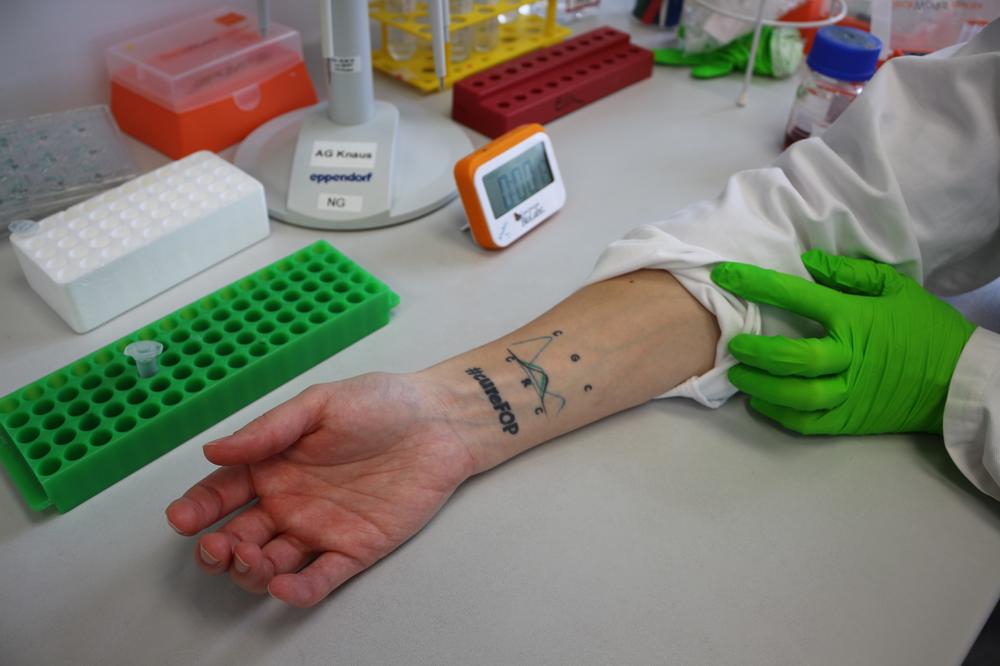When Muscles Turn to Bone
Biochemist Nadine Großmann is conducting research at Freie Universität on her own rare disease FOP, which causes the body to ossify progressively
May 12, 2020
For the past year, Nadine Großmann has been doing research at Freie Universität on the rare genetic disease FOP.
Image Credit: Dennis Yücel
There are disorders that are so rare that even most medical doctors have never heard of them. One of them is called Fibrodysplasia ossificans progressiva, or FOP for short. Only around 40 cases of the genetic disease are known in Germany. “The disease causes bones to grow in places where they don't belong,” states Nadine Großmann. “It progressively ossifies muscles and connective and supporting tissue.” For those affected, this is often associated with severe restrictions in movement. “The process of progressive ossification usually starts during the first few years of life whereby bones develop step by step in the body and block the joints,” says Nadine Großmann. In addition to stiffening of the cervical spine, there is often considerable stiffness at the shoulder joints and the entire shoulder girdle. By the end of puberty, all the large joints close to the trunk are stiffened, so that those affected can only move around to a limited extent and are usually dependent on outside help.
Nadine Großmann is a doctoral student at the Institute of Chemistry and Biochemistry at Freie Universität and is herself affected by FOP. For the past year, she has been doing research on her own disorder in the laboratory of Petra Knaus, a professor of biochemistry. She explains that in their research group they investigate bone morphogenetic proteins (BMPs), which are signal proteins that play a major role in development as growth factors that stimulate bone formation.
The faulty bone formation in those affected by FOP has to do with how the body deals with BMPs. “Receptors on the cells transmit signals to the interior of the cell,” says Nadine Großmann. “Due to an error – a single wrong letter in the genetic code – in the gene of the ACVR1 receptor (also called ALK2), which belongs to the BMP receptor family, the receptor is over-activated, which in turn can lead to excessive bone formation,” explains Großmann.
In FOP, extraskeletal bone formation during so-called flare-ups occurs episodically, but also continuously at various speeds. On the one hand, this can be attributed to external factors such as muscle injuries due to falls, but also to vaccinations. However, flare-ups can occur again and again without any external influence. “Sudden inflammations occur, whereby we do not exactly know the internal triggers,” says Nadine Großmann.
Currently, there are no treatment options for the disease. Therefore, attempts are made to dampen flare-ups with anti-inflammatory drugs. Due to the rarity of the genetic defect, knowledge about FOP is not very widespread. “There are very few medical doctors who are familiar with FOP,” explains Nadine Großmann, “which is why the journey to a correct diagnosis can take several years.”
Nadine Großmann is committed to raise awareness for the disease. She had the hashtag #cureFOP tattoed on her forearm.
Image Credit: Dennis Yücel
Nadine Großmann did not experience the first symptoms until she was 13 years old. Nevertheless, even after the correct diagnosis, she and her parents were given very little information. There was, in fact, no information available as to whom she could consult and how she could manage her daily life in order to live as well as possible with the disease. “I lived with the disease for a long time, just hoping it wouldn't get worse,” she says. “But due to a lack of communication among the involved physicians, quite a lot went wrong during the treatment.”
Errors in Treatment due to a Lack of Knowledge
In Großmann's case, the hip, shoulder and jaw are mainly affected. When walking, she can only limp while bending forward, and she can't raise her right arm higher than her shoulder. The mouth can only be opened to a very limited extent after a jaw operation. “Today I know that operations should definitely be avoided,” says Großmann. “These types of mistakes happen because FOP is so rare and therefore too unknown.”
In addition to her scientific work, Nadine Großmann is committed to raising awareness for the disease and creating networks for those affected along with medical doctors and researchers. Since 2017, she has been the vice chair of the FOP association (Verein) in Germany. She does educational work on social media under the hashtag #cureFOP, which she had tattooed on her forearm.
Großmann regularly takes part in international conferences, which is where in 2017 in Sardinia, she met her current doctoral supervisor Petra Knaus. Following an internship in the Knaus lab, she joined her research group devoted to signal transduction, where another doctoral student, Susanne Hildebrandt, was already doing research on FOP. Großmann says that learning that a number of scientists were already doing research on FOP had a profound effect on her. Furthermore, they are now aiming to establish FOP research more firmly and broadly at Freie Universität.
The original German version of this article was published on April 17, 2020, in campus.leben, the online magazine of Freie Universität Berlin.


